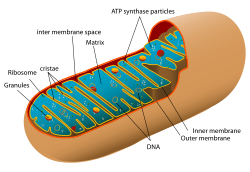Mitochondria The Powerhouses of Our Cells

Mitochondria are often referred to as the “powerhouses” of our cells, and for good reason. These microscopic organelles play a crucial role in energy production, cellular metabolism, and maintaining the overall health of our bodies. In this article, we’ll explore what mitochondria are, how they function, and why they’re so important for our health.
What Are Mitochondria?
Mitochondria are small, double-membraned organelles found in nearly every eukaryotic cell (cells with a defined nucleus). These tiny structures range from 0.5 to 10 micrometers in size and are most commonly associated with energy production. Mitochondria have their own DNA, distinct from the nuclear DNA found in the cell’s nucleus, which hints at their evolutionary origins.
The main job of mitochondria is to produce energy in the form of adenosine triphosphate (ATP) through a process called oxidative phosphorylation. However, they also play a role in other critical cellular functions, such as regulating cell death (apoptosis), calcium storage, and heat production. This diverse functionality makes mitochondria essential for the proper functioning of our bodies.
The Structure of Mitochondria
The structure of mitochondria is quite unique and complex, allowing them to carry out their various functions effectively. Mitochondria are composed of two membranes:
- Outer Membrane: This is smooth and semi-permeable, allowing small molecules and ions to pass through. The outer membrane serves as a protective barrier and defines the shape of the mitochondrion.
- Inner Membrane: The inner membrane is folded into structures known as cristae. These folds increase the surface area of the membrane, providing more space for the proteins involved in ATP production. The inner membrane is where most of the energy-producing reactions take place.
The space between the outer and inner membranes is called the intermembrane space, while the interior of the mitochondrion, enclosed by the inner membrane, is called the matrix. The matrix contains enzymes that assist in the citric acid cycle (also known as the Krebs cycle), a key part of energy production.
The Role of Mitochondria in Energy Production
The most well-known role of mitochondria is their involvement in ATP production. ATP is the energy currency of the cell, fueling a wide range of cellular processes. Mitochondria produce ATP through a series of biochemical reactions involving glucose, fats, and oxygen.
Glycolysis: The First Step
Before mitochondria take over energy production, the process starts in the cytoplasm of the cell with glycolysis. In glycolysis, glucose is broken down into pyruvate, producing a small amount of ATP. This process doesn’t require oxygen and occurs in both aerobic and anaerobic conditions.
Citric Acid Cycle (Krebs Cycle)
Once the pyruvate enters the mitochondria, it is converted into Acetyl-CoA, which enters the citric acid cycle. During this cycle, carbon dioxide is produced, and high-energy molecules such as NADH and FADH2 are generated. These molecules are then used in the next step to produce ATP.
Oxidative Phosphorylation
The final and most efficient phase of ATP production takes place in the inner membrane of the mitochondria through a process known as oxidative phosphorylation. Here, electrons from NADH and FADH2 pass through the electron transport chain, which consists of protein complexes embedded in the inner membrane. As electrons move through these complexes, protons (H+) are pumped into the intermembrane space, creating an electrochemical gradient.
This gradient is used to power the ATP synthase enzyme, which produces ATP from ADP and inorganic phosphate. Oxygen plays a crucial role in this process by acting as the final electron acceptor, combining with electrons and protons to form water. Without oxygen, oxidative phosphorylation cannot occur, which is why it’s known as an aerobic process.
The Role of Mitochondria in Other Cellular Functions
While energy production is the primary function of mitochondria, these organelles are involved in several other key processes in the cell. Some of these include:
1. Cellular Respiration and Metabolism
Mitochondria regulate cellular respiration by controlling the breakdown of nutrients like glucose and fatty acids. They also participate in the breakdown of amino acids, contributing to the metabolism of proteins and fats. This makes them central to the body’s overall metabolic processes.
2. Calcium Storage and Signaling
Mitochondria help maintain calcium balance within the cell. Calcium ions are important signaling molecules that regulate processes like muscle contraction, neurotransmitter release, and enzyme activity. Mitochondria can absorb and release calcium ions as needed, ensuring proper cellular function.
3. Apoptosis (Programmed Cell Death)
Mitochondria play a key role in apoptosis, the process of programmed cell death. When a cell is damaged or no longer needed, mitochondria release proteins that activate a cascade of events leading to cell death. This is an important mechanism for maintaining the health of tissues and preventing the growth of cancerous cells.
4. Heat Production
In addition to generating ATP, mitochondria are involved in thermogenesis (heat production) in certain cells, particularly in brown adipose tissue (fat cells). This process helps to maintain body temperature in cold environments by burning stored fats.
Mitochondria and Aging
As we age, the function of mitochondria tends to decline. This is known as mitochondrial dysfunction and is thought to contribute to many age-related diseases, such as Alzheimer’s, Parkinson’s, and cardiovascular diseases. The decline in mitochondrial function may result from accumulated damage to mitochondrial DNA (mtDNA) or from the gradual breakdown of mitochondrial components.
Interestingly, some research suggests that boosting mitochondrial function could delay the effects of aging and help prevent age-related diseases. Strategies such as exercise, healthy diet, and certain supplements may help support mitochondrial health.
Mitochondrial DNA: A Glimpse into Evolution
Mitochondria are unique in that they have their own DNA, which is separate from the nuclear DNA in the cell’s nucleus. Mitochondrial DNA (mtDNA) is inherited solely from the mother, as sperm mitochondria are typically discarded during fertilization.
Because mtDNA is passed down maternally and has a higher mutation rate than nuclear DNA, scientists have used it to trace human evolutionary history. By examining mitochondrial DNA from ancient human remains, researchers have been able to build genetic family trees, shedding light on how humans migrated across the globe.
Mitochondria and Disease
Mutations in mitochondrial DNA or problems with mitochondrial function can lead to a variety of diseases. Since mitochondria are responsible for energy production, any disruption in their function can have widespread effects on the body, especially in energy-demanding tissues like muscles and the brain.
Mitochondrial diseases are often inherited and can affect organs such as the heart, liver, and kidneys. Some common mitochondrial disorders include:
- Leber’s Hereditary Optic Neuropathy (LHON): A condition that leads to sudden vision loss.
- MELAS Syndrome: A mitochondrial disorder that causes muscle weakness, strokes, and seizures.
- Kearns-Sayre Syndrome: A rare disease that affects the heart, eyes, and muscles.
The Future of Mitochondrial Research
Research into mitochondria continues to expand, as scientists uncover more about their role in health and disease. In particular, there is growing interest in mitochondrial therapy, which could involve replacing damaged mitochondria with healthy ones or developing drugs that enhance mitochondrial function.
Moreover, mitochondrial transplantation, where healthy mitochondria are injected into patients with mitochondrial diseases, is an area of active research. Though still in its early stages, such treatments may one day offer hope for those suffering from mitochondrial disorders.
Conclusion
Mitochondria are far more than just the cell’s powerhouses. These remarkable organelles are involved in a wide range of essential processes, from energy production to apoptosis and calcium signaling. Understanding mitochondria’s role in human health has the potential to transform medicine, especially in the treatment of age-related diseases and mitochondrial disorders. As research continues to evolve, we are likely to discover even more ways these tiny structures impact our overall well-being.




